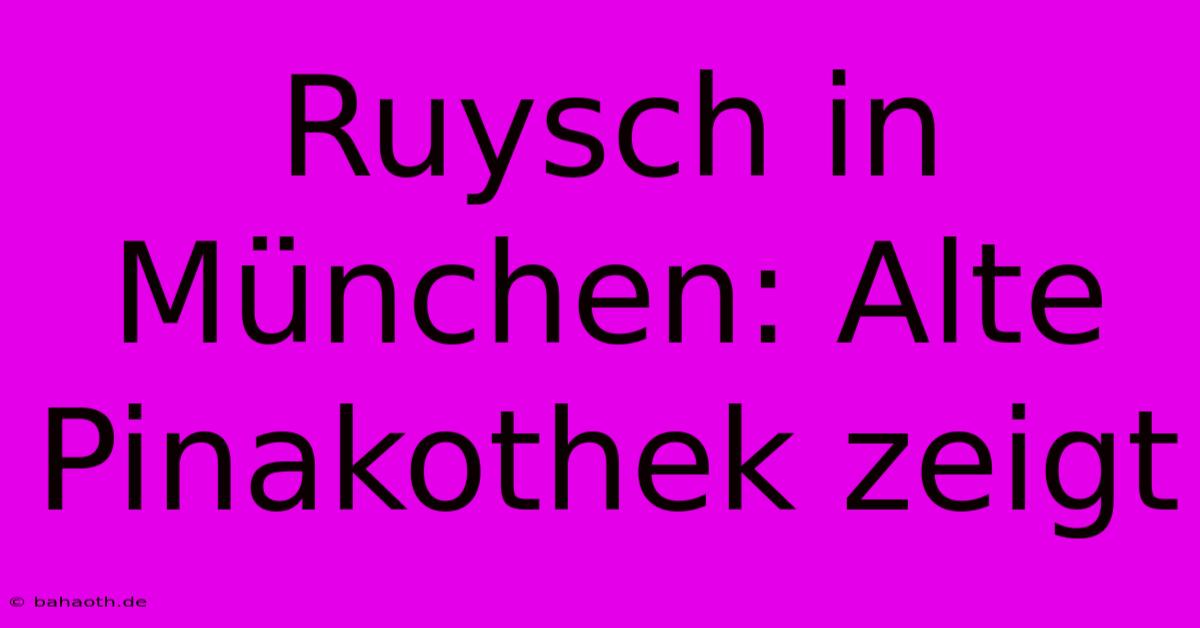Ruysch In München: Alte Pinakothek Zeigt

Discover more detailed and exciting information on our website. Click the link below to start your adventure: Visit Best Website Ruysch In München: Alte Pinakothek Zeigt. Don't miss out!
Table of Contents
Ruysch in München: Alte Pinakothek zeigt – A Breathtaking Exhibition
Hey everyone! So, I just got back from the Alte Pinakothek in Munich, and wow, let me tell you – the Rachel Ruysch exhibition was amazing. Seriously, if you're even remotely interested in 17th-century Dutch Golden Age painting, or just stunning floral still lifes in general, you have to check it out before it closes. I almost didn't go, because, you know, life, but I'm SO glad I did. It totally changed my perspective on Baroque art.
<h3>My initial skepticism (and a near-miss!)</h3>
I'll admit, I was a little hesitant at first. Floral still lifes? Sounds a bit... blah, right? I mean, I appreciate art, sure, but I’m more of a "gritty realism" kind of guy, usually. I almost skipped it, opting instead for another museum. My friend, Sarah, dragged me, practically kicking and screaming, I’m not going to lie.
But, man, was I wrong. Dead wrong.
<h3>The sheer artistry of Ruysch's work</h3>
The detail in Ruysch's paintings is insane. I mean, seriously insane. Each petal, each dewdrop, each tiny insect... it's like she's captured the very essence of life itself. It’s the kind of detail that makes you want to grab a magnifying glass (though I resisted, haha!) It's not just pretty flowers; it's about the symbolism too – the fleeting nature of beauty, the passage of time. The whole thing is incredibly moving.
There were probably around 30 or so pieces, but the variety was incredible. Some were huge, filling whole walls, while others were smaller, more intimate studies. They all had a similar technique though: almost photographic realism, but with an almost ethereal quality. She didn't just paint flowers; she painted light and shadow, and somehow managed to make even the deadest-looking petals feel alive.
<h3>Beyond the blooms: Technical mastery and historical context</h3>
What really blew me away was the sheer technical skill. The way she rendered the textures – the velvety softness of petals, the delicate fragility of stems – was just breathtaking. The exhibition did a great job of providing context too. It wasn't just about admiring the paintings; it gave you a real sense of Ruysch's life and the world she lived in. They talked a lot about her social standing as a woman artist. The whole display was cleverly done.
<h3>Actionable tips for your own visit (and improving your own art appreciation skills!):</h3>
-
Go early: Avoid the crowds! I got there just as they opened, which let me really soak in the paintings without feeling rushed or stressed.
-
Take your time: Don't rush through the exhibition. Each piece deserves your attention. Really look at them – notice the details, the brushstrokes, the colors. It's a marathon, not a sprint.
-
Read the descriptions: The descriptions help immensely in understanding the context and meaning of the artwork. I usually skip those, but I'm glad I didn't this time. Learning about the history helps you appreciate the art.
-
Take notes (or photos): I always take a notebook now. It helps me remember what moved me. If you take photos, make sure to turn off the flash!
-
Share your experience: Tell your friends! Let them know about this incredible exhibition. Word of mouth is so important for events like this.
This exhibition really reignited my passion for art history. I’d totally recommend it – it's more than just pretty pictures; it's a masterclass in artistic skill and a window into a fascinating historical moment. Seriously, go check it out! You won't regret it. And tell Rachel Ruysch I said hi (she’s long gone, obviously, but still).

Thank you for visiting our website wich cover about Ruysch In München: Alte Pinakothek Zeigt. We hope the information provided has been useful to you. Feel free to contact us if you have any questions or need further assistance. See you next time and dont miss to bookmark.
Featured Posts
-
Ruysch Blumenmalerei Alte Pinakothek
Nov 27, 2024
-
Bayern Vs Frankreich Fans Sehen Sieg
Nov 27, 2024
-
Atalantas Offensive Angriff Auf Europa
Nov 27, 2024
-
Rb Leipzig Fuenf Niederlagen In Serie
Nov 27, 2024
-
25 11 Feux De L Amour Folge 6697 Auf Rtbf
Nov 27, 2024
